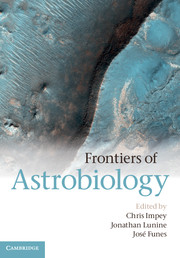Book contents
- Frontmatter
- Contents
- List of contributors
- Part I Introduction
- Part II Origin of Planets and Life
- Part III History of Life on Earth
- Part IV Habitability of the Solar System
- 8 Early Mars – Cradle or Cauldron?
- 9 Large Habitable Moons
- 10 Small Habitable Worlds
- Part V Exoplanets and Life in the Galaxy
- Index
- Plate Section
- References
8 - Early Mars – Cradle or Cauldron?
from Part IV - Habitability of the Solar System
Published online by Cambridge University Press: 05 December 2012
- Frontmatter
- Contents
- List of contributors
- Part I Introduction
- Part II Origin of Planets and Life
- Part III History of Life on Earth
- Part IV Habitability of the Solar System
- 8 Early Mars – Cradle or Cauldron?
- 9 Large Habitable Moons
- 10 Small Habitable Worlds
- Part V Exoplanets and Life in the Galaxy
- Index
- Plate Section
- References
Summary
Mars constitutes one of the most interesting settings for astrobiological studies, not only due to its proximity to Earth, but also because it is conceivable that life may have originated in this seemingly barren planet. Mars has captured man's imagination since the time of Giovanni Schiaparelli, who in 1877 published a detailed map that became a standard reference in planetary cartography. Schiaparelli's original map showed a network of linear markings which went across the entire Martian surface joining different dark areas to one another. He referred to these lines as canali and named them after famous rivers. The Italian word canale (plural canali) was soon incorrectly translated to English as “canals,” which denotes artificially made ducts. Being aware of this mistranslation, Schiaparelli stated that
[T]hese names may be regarded as a mere artifice…After all, we speak in a similar way of the seas of the Moon, knowing very well that they do not consist of liquid masses.
Thus, the idea of artificially made water courses remained, implying that Mars was a planet harboring life. Later on, Percival Lowell fueled further speculations about possible Martian life forms in his book Mars as the Adobe of Life (1908), popularizing the view that these markings were manifestations of an intelligent civilization.
One can analyze the possibility of life on Mars taking into consideration the different geological ages of this planet (now under revision). The Noachian period (named after Noachis Terra), which took place between 4.5 and about 3.7 billion years ago (Gya), is considered to be the warm and wet age of the planet. Extensive erosion by liquid water produced river valley networks whose marks have survived to the present time. There may even have been extensive lakes and oceans at this time, though evidence for such features is at present ambiguous. Thereafter, the Hesperian (named after Hesperia Planum) or volcanic period, from 3.7 to approximately 3.0 Gya, showed catastrophic releases of water that carved extensive outflow channels, with ephemeral lakes or seas. Finally, there is the Amazonian period (named after Amazonis Planitia), which extends from 3.0 Gya until today. It is considered the cold and dry period of Mars, with glacial/periglacial activity and minor releases of liquid water.
- Type
- Chapter
- Information
- Frontiers of Astrobiology , pp. 157 - 174Publisher: Cambridge University PressPrint publication year: 2012



